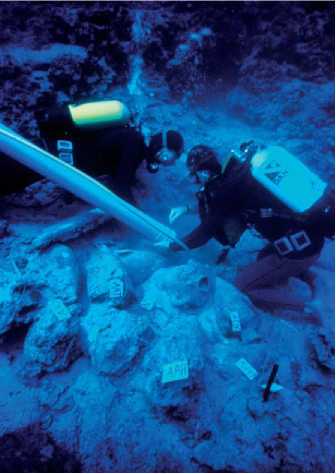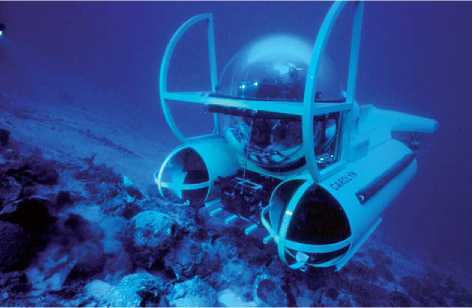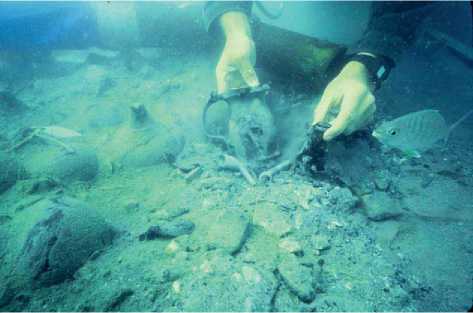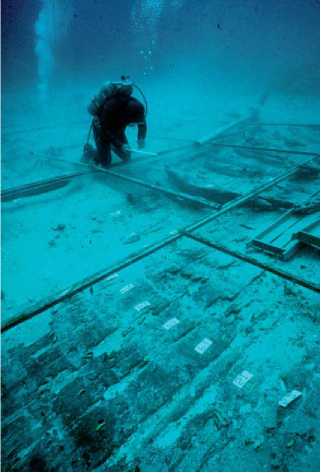Autonomous underwater vehicle (AUV) A crewless, untethered submersible that operates independent of direct human control.
Diving physiology Functioning of organisms or their parts during diving.
Remotely operated vehicle (ROV) An unmanned subsea vehicle remotely controlled from a vessel or an offshore platform. scuba Self-contained underwater breathing apparatus. shipwreck The remains of a wrecked ship. sonar A technique that uses sound propagation under water to navigate or to detect other objects underwater archaeology The process of excavating archaeological material covered by freshwater or seawater.
Underwater archaeology differs from terrestrial archaeology only in its requirements for different tools and techniques. Their aims are identical.
The underwater archaeologist, unless using robotic devices operated remotely from the surface, must dive, which requires carrying a tank of compressed air or being tethered to the surface with an air hose in order to breath. The development in the 1940s of modern scuba (self-contained underwater breathing apparatus) freed divers from hoses, helmets, and cumbersome diving suits, providing the freedom and agility required for delicate archaeological work. Even scuba, however, cannot free the underwater archaeologist from the physiological limits of diving caused by the weight, or pressure, of water, which increases as depth increases. As humans descend, they must breathe air at a pressure equal to that of the water around them to prevent their lungs, ears, sinuses, and other air-filled body cavities from being crushed. Diving equipment, whether scuba or that dependent on air pumped down from the surface through a hose, provides the necessary pressurized air. Even so, the diver’s depth and time are limited.
For physiological reasons, air cannot be breathed at great pressure, so the deepest underwater site so far excavated on an air supply was a Bronze Age shipwreck 145-200 feet deep off Uluburun, Turkey (Figure 1), and even that required specialized techniques and equipment. Excavators can descend deeper by breathing various gas mixtures, especially helium and oxygen, as during the excavation of an ancient shipwreck off Sicily, but it greatly increases costs and complexity. There are, however, myriad sites worthy of excavation in air-diving depths.
The main factor that separates underwater archaeology from terrestrial archaeology is the limitation of time, again caused by diving physiology. The pressurized air breathed by divers is absorbed by their bodies. If divers rise too quickly, this air will come out of solution and form bubbles in their blood, like the bubbles that form when the cork is removed from a champagne bottle, suddenly releasing the pressure. Bubbles in the blood can cause pain, paralysis, or death. To avoid this illness, commonly called the bends, the diver must rise to the surface in stages, following carefully calculated schedules, breathing off the pressurized gas. The deeper the dive and the longer the stay, the longer the decompression. For practical purposes, an excavator working 120 feet deep is limited to two dives of 20 min each day. In contrast, in only 33 feet of water the limiting factor is comfort. Compare the ability of a terrestrial archaeologist to survey or excavate for many hours at a stretch.
Clearly, then, archaeologists who search for underwater sites cannot duplicate their terrestrial counterparts, who can walk for hours while observing the ground beneath their feet. Nor can underwater archaeologists, even in the clearest water, visually observe large areas at a time, as from airplanes that conduct aerial surveys for land sites. Instead, they often must depend on remote sensing equipment to locate underwater sites (see Remote Sensing Approaches: Aerial; Geophysical).
Sonar emits sound waves that are reflected from underwater objects, producing images on monitor screens or on paper, even if, like the ship Titanic, the

Figure 1 Excavators airlift sediment from Canaanite jars on a fourteenth-century BC shipwreck at Uluburun, Turkey. Reproduced with permission from the Institute of Nautical Archaeology.
Objects lie miles deep. Sonar does not yet provide images of photographic clarity, however, so the sonar operator cannot always distinguish ancient cargos of pottery from rocks on the seabed. Nevertheless, sonar produces targets that can be examined and identified by lowered television cameras, or from human-occupied submer-sibles. Sub-bottom sonar penetrates the sea floor and can detect remains that lie invisible below sediment, but because it must be aimed almost directly downward, it cannot search large areas at a time.
Magnetometers detect iron, making them especially useful in surveys for wrecks with steel hulls, or with large iron items such as anchors or cannons. Detectors for other metals, however, are usually so limited in range that they are not useful for random surveys.
Surveys for shipwrecks in shallow water have been conducted successfully from the air, in some instances by observers using hot-air balloons from which they spot mounds of ballast stones, but visual surveys by divers for the better-preserved, deeper wrecks are normally unable to cover great distances efficiently. To overcome both time and depth limitations, visual surveys can be conducted from submersibles (Figure 2), ranging from those capable of diving only a hundred or so feet deep to those capable of descending for miles, or by means of closed-circuit television, especially if part of an ROV (remotely operated vehicle, connected to the surface by cables) or an AUV (autonomous underwater vehicle, which independently travels a predetermined course like a torpedo).

Figure 2 The Institute of Nautical Archaeology’s submersible Carolyn over a fourth-century BC cargo of amphoras off the Turkish coast. Reproduced with permission from the Institute of Nautical Archaeology.
The types of sites discovered by underwater surveys do not differ radically from those found on land (see Pedestrian Survey Techniques). Although archaeologists who specialize in the study of ships, called nautical archaeologists, often work below water, they also study watercraft on land, such as Viking ships buried in Scandinavia or Greek and Roman hulls in silted Mediterranean harbors or steamboats whose rivers have changed course in the United States, leaving their hulls and cargos under dry earth. Similarly, inundated towns resemble terrestrial habitation sites. Even cenotes, the sacred wells of Middle America, do not differ greatly from caves in which generations of worshippers have dedicated gifts to their gods.
One difference between underwater sites and terrestrial sites is that the former, often resulting from shipwreck or earthquake, contain complete spectra of material remains from specific moments in time, usually remarkably well preserved, and undisturbed by later human activity. An example of a site at which cataclysmic destruction kept the contents of its houses and other structures intact is Port Royal (Figure 3), Jamaica, which sank during an earthquake in 1692.
Once a site worthy of excavation has been identified, it is excavated with the same exacting controls as any land site. Underwater archaeologists, like their terrestrial counterparts, have a responsibility to document the progress of their excavations (Figure 4), since once excavated a site is destroyed and cannot be excavated again. Hand measurements with meter tapes can be useful for mapping shallow sites, where time is less limited, but on deeper sites mapping must be accomplished more rapidly, usually by digital photography, if the water is sufficiently clear, combined with various computer programs. To overcome lack of visibility in the York River, Virginia, archaeologists

Figure 3 Excavating at the seventeenth-century sunken city of Port Royal, Jamaica. Reproduced with permission from the Institute of Nautical Archaeology.

Figure 4 Mapping the hull of an eleventh-century Medieval shipwreck at Serce Limani, Turkey. Reproduced with permission from the Institute of Nautical Archaeology.
Constructed a cofferdam around a ship lost in the American Revolutionary War and clarified the water inside with industrial filters.
Overburden is usually removed from underwater sites by fanning the sediment gently away by hand, especially if there is a slight current. This gives underwater excavators the ability to dig as carefully as land excavators using trowels and brushes. Either airlifts or underwater dredges keep water clear in front of the excavator by transporting the disturbed sediment away from the site. Airlifts are nearly vertical pipes, usually of plastic, that suck up the suspended silt and sand and discharge it high above the site, usually into A current but sometimes into a sieve floating on the surface. Underwater dredges operated by pressurized water carry overburden away horizontally.
Heavy objects or groups of object can be raised to the surface by cranes and other lifting devices, but also by balloons that are attached to the objects and then inflated on the sea bed. An adjustable vertical pipe in a rising balloon allows expanding air to bubble out of the balloon’s top, thereby preventing the balloon from becoming so buoyant that it might escape the control of a diver ascending with it.
Although shipwrecks thousands of feet deep have been accurately mapped by remotely operated cameras, and although machines have been built that allow shipboard operators to pick up the tiniest of artifacts with small suction hoses at these depths, no underwater site has yet been fully excavated by such devices.
Once on the surface, artifacts must be conserved. Waterlogged artifacts should not be allowed to dry quickly, for wood and other organics will shrink and warp beyond recognition, and metals will oxidize; even ceramics suffer from uneven drying of the exterior and interior clay (see Sites: Waterlogged).
Conservation, conducted by trained conservators, can continue for years after the excavation is completed. Its primary objective is to extend the life of specimens so they will be available for study and display for future decades. This is a simple goal but a complex problem. Salt water is highly corrosive to metal artifacts, which become encrusted with thick layers of marine concretion, thoroughly disguising them. Waterlogged and sea-encrusted metal artifacts, ranging in size from single coins to anchors or cannons weighing tons, require special conservation procedures, such as electrolysis for iron, to keep the material from deteriorating (see Conservation and Stabilization of Materials). Each encrustation must first be radiographed, however, to determine the nature of its encapsulated artifacts, which must be mechanically extracted; if the iron inside the concretion has disappeared through corrosion, the cavity it leaves in the concretion can be filled with liquid epoxy which, when hard, makes a perfect replica of the original object. Once removed from concretion, the different metals, organic materials, ceramics, and glass require different procedures to conserve and ready them for analyses to determine their manufacturing technology, origins, and parallels at other sites. Wood, for example, must be chemically treated, often with polyethylene glycol, which can take years. Research is continuing to develop new conservation techniques, such as the use of silicone oil, to conserve fragile organic material. It is only after the work of the conservation laboratory is completed that final reports can be written and museum displays prepared.
See also: Conservation and Stabilization of Materials; Pedestrian Survey Techniques; Remote Sensing Approaches: Aerial; Geophysical; Robotic Archaeology on the Deep Ocean Floor; Sites: Waterlogged.




 World History
World History









